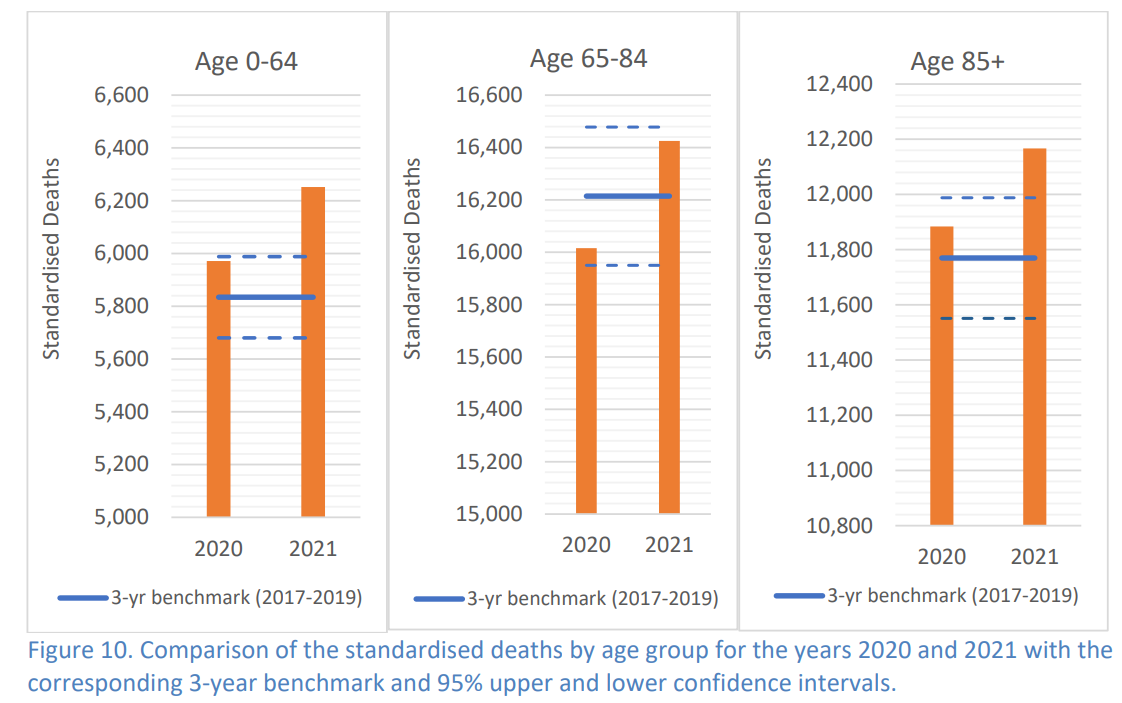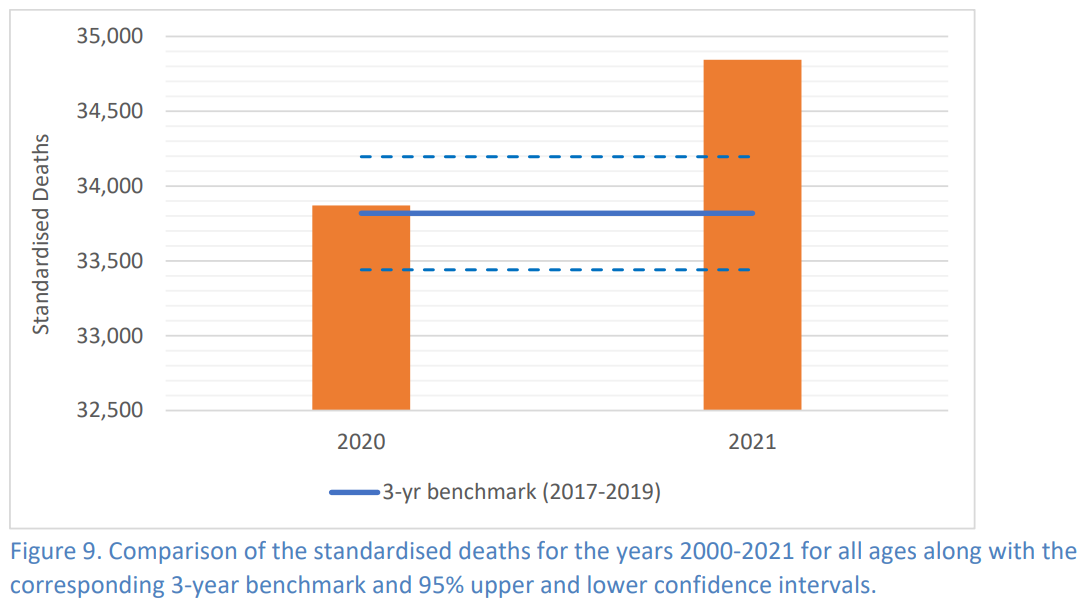Clowns to the left, Jokers to the right
Here I am, (a truthseeker) stuck in the middle with you...
Witzbold’s review of the latest contribution to the debate circus around excess death estimations in Ireland during the pandemic - these new and improved (under)estimates are brought to you courtesy of the Society of Actuaries in Ireland (SAI)!
Actuarial Science is Serious, Right?
After documenting the apparent professional incompetence of the Statistics and Analytics Unit in the Irish Department of Health reporting on OECD estimates of Ireland’s pandemic excess deaths, we might reasonably expect actuaries ought to have more valuable insight when it comes to assessing the extent of excess mortality both during and since the pandemic. Measuring and estimating the statistical probability and risk of future events is a core competency of actuarial science, for example, calculating life expectancy tables in order to accurately price life assurance policies.
Statistical Accuracy for Serious Profit
Indeed, beyond a rarefied field of statistical academia, actuaries have to apply their theories with statistical calculations to real-life markets for substantial sums of money at play in the lucrative global game of profit-making. The more accurate the actuarial calculations, the better this knowledge can be competitively leveraged against other financial institutions - it pays to be accurate.
So, one might have high expectations for this report which says it builds on previous credible work carried out by the Society of Actuaries Covid-19 Action Group (see COVID-19 Action Group blog) - although the authors of that pandemic blog were clearly biased toward lockdowns and vaccination. Unfortunately, this report joins the ranks of previous ones chronically underestimating Irish excess mortality since 2021.
Basic Flaws
All published estimates of excess deaths for Ireland to date have suffered from, at least one, of the following three basic flaws:
#1 data basis - incomplete/provisional
(due to opaque and protracted nature of Irish death registrations)#2 failure to adjust for population size AND structure
(Ireland’s population has experienced rapid growth and significant aging)#3 ignore long-term trend of falling mortality rates and rising life expectancy
(simple arithmetic averages of previous years are NOT appropriate baselines - see my translation of Statistical Distortions by Marcel Barz)
The authors have laudably tried to address issues around the data by limiting their analysis up to 20211 and, with regard to population changes, they have employed age-standardised death totals. Alas and alack, they willfully neglect #3, long-term mortality trends.
Recall, the authors of the OECD report addressed issue #2 but fell foul of #1 and #3, in that respect, the SAI report can be considered an improvement.
Nonsense Pre-bunking?
The first red flag is that the SAI bizarrely try to pre-bunk reasonable expectations which readers of their paper might entertain upon seeing their results:
A reader observing the significant downward trend in mortality from 2010-2019 (see Figure 3), might reasonably expect that, in the absence of Covid-19, the trend would have continued into 2020-2021 resulting in lower expected deaths and hence a higher number of excess deaths or higher excess mortality
The authors have calculated standardised death totals based on the 2021 population, i.e. the 2021 death total is the actual (current) officially recorded deaths occurrences and the other years’ totals are all standardised to the 2021 population structure by using the age-specific death rates recorded in those respective prior years. The graph shows that pre-pandemic (2016 and earlier) mortality rates were significantly higher, though actual death totals were lower since it was a smaller population with less elderly. (See previous posts, here, and here where I used a similar technique).
However as stated above, we opted to calculate the expected mortality for 2020 and 2021 by using the average observed mortality from 2017 to 2019. [Witzbold: Authors stated their choice of method, but without any justification.]
Then this nonsensical sentence:
This method is objective as it relies on actual recorded data from those years.
*Facepalm* That is NOT objectivity! The data-basis may be actual (as opposed to modelled) but that does not make the author’s choice objective. They opted to employ the method of a simple arithmetic average, which is a subjective choice! Furthermore, the choice seems entirely subjective, as the authors have made no substantial arguments in it’s favour, other than it was “A common approach during the Covid-19 pandemic…”

[EDIT: the red illustrative arrow 2019-2021 has been redrawn to reflect the deficit mortality of 2019]
Don’t Believe Your Lying Eyes
Above is the diagramme of death totals standardised2 to the 2021 population. I have had to eyeball my addition of pre-pandemic (blue line) and pandemic (red line) trends. It is not too dissimilar to my own age-standardised graphic from previous post, “Revisiting Lies of Omission” based on European Standard Population 2013 using CSO’s 5-year standard age-bands data (see footnote 1 below).
The authors describe the ill-fitting orange dotted line in the above graphic as “…the trend in the standardised deaths over the period 2010-2021”, strangely choosing to plot this line instead of a reasonably-fitting line (blue line, my edit) of the pre-pandemic 2010-2019 trend, and the pandemic 2020-2021 trend (red line, my edit).
Confirmation of Reversal of Trend
The authors own results confirm the significant reversal of trend which has occurred in Irish mortality (for those with eyes to see). The long-term pre-pandemic falling trend in age-adjusted mortality was arrested in 2020 and has continued to climb since. This has been repeatedly denied/ignored/obfuscated about by the authorities in Ireland and covered extensively at this substack.
Jokers
Inadvertently, the above dotted line in the graphic visually suggests 2017, 2018 and 2019 were years of significant deficit deaths, with 2020 being on trend, and only 2021 exhibiting indications of excess deaths. Note also, the authors chosen methodology of preceding 3-year average as baseline would have resulted in continual estimates of deficit deaths going back over at least a decade! So their method resoundingly fails as a measure of excess deaths when applied to historical data.
All else being equal in prediction exercises, the inclusion of more experience data (in this case, years) strengthens the statistical significance of a benchmark. However, the significant downward trend in mortality observed in the period 2010 to 2019, renders the earlier years less useful as a predictor of mortality in 2020 and 2021.
Allow me to translate: “even though more data points fitted the long-term trend lending it more statistical significance, because we insisted on using a simple arithmetic average as a benchmark baseline (for no good reason), i.e. being unwilling to countenance mortality rates might have continued to fall in the absence of the pandemic, we have ignored the consistent long- and medium-term trend to myopically focus on the immediately preceding 3-year range of standardised deaths.”
The authors even seem to have conveniently fudged their figures claiming the annualised decline in standardised deaths from 2015 (~36,200) to 2019 (~33,000) over four years was less than from 2017 (~34,400) to 2019 (~33,000) over two years - say what?
Let’s be Honest
It is important to note however, that this analysis does not attempt to estimate what expected deaths might have been in 2020 and 2021 had the significant downward trend in mortality rates observed in the period 2010-2019 continued.
- Society of Actuaries in Ireland (SAI)
*Sigh*, there you have it, these professional actuaries decided not to apply their statistical skills to taking long- and medium-term trends into account when calculating their estimates of Irish excess deaths in 2020 and 2021. For example, they could have done so, and made that an upper bound on excess deaths, and set their preferred method as the lower bound, which would have resulted in quite a meaningful range of estimation. Admittedly, 95% confidence intervals are offered in Appendix 2.
Honour Amongst Statisticians
Here is a quote from the Irish Department of Health’s Statistics and Analytics Unit who have not been kindly reviewed in previous Witzbold’s Newsletters:
There is a high reputational interest for the Statistics and Analytics [Unit] in assuring the accuracy and reliability of our statistics. Due to the nature and scope of our role, our statistical outputs form the basis of budgetary and policy analysis.
Similarly, there should be high reputation interest for the Actuaries of Ireland in the competence of their analysis of excess mortality in their homeland.
Oops - More Lies of Omission
One aspect of the SAI report worth exploring more closely is the age-standardised excess deaths by three broad age bands: 0-64, 65-84, and 85+

The authors write:
As can be seen, age groups 0-64 and 85+ experienced excess mortality in both 2020 and 2021 while age group 65-84 only experienced excess mortality in 2021. The excess deaths in 2020 for ages 0-64 and 85+, and in 2021 for ages 65-84, were relatively small and could be due to normal fluctuations.
Why do the SAI authors emphasise death totals in a paper that went to great lengths to calculate age-standardised mortality rates? And why do they bizarrely opt to present the excess deaths per age band as a % of the relevant age-group population?
[==EDIT(11.06.24)== added below quote from SAI report:]
As expected, individuals aged 85+ had the highest excess deaths as a percentage of population (0.147% and 0.512%) for both 2020 and 2021, despite individuals aged 0-64 having the highest absolute number of excess deaths (137 and 418) in those respective years
That’s right, not as a conveniently comparable percentage of the expected baseline deaths within that specific age-group, a so-called P-score, as featured by Human Mortality Database and One World in Data:
Perhaps, because it would reveal some uncomfortable trends…

According to the SAI report and their own figures, the 0-64 group disproportionately experienced excess deaths more so than both the 65-84 group and the 85+ group in both 2020 and 2021. A word of caution, these are very unwieldy, broad age groups and that always invites aspects of Simpson’s paradox to undermine prospective conclusions. However, it does speak to long-held suspicions that the younger were ultimately disproportionately affected in the cumulative all-cause mortality impact of the pandemic years. This is strongly at odds with the heavily reported age-stratified profile of Covid’s impact.
As this substack has previously pointed out, the age-specific mortality rates of younger cohorts are also much more sensitive to late registrations being added to the “final” CSO totals presumably used by the SAI authors because they are disproportionately represented in the late registrations. So there is potential for this discrepancy to worsen.
Jokers Mirroring Clowns
There is a lot of posting on social media about a figure of 17~18k (17~18 thousand) excess deaths in Ireland during the pandemic period of 2020-2023. The figure seems to stem primarily from analysis of death totals based on public death notices at RIP.ie, and (ironically) the same basic flaw of using a flat average of a multi-year period prior to the pandemic as a baseline. The same methodological flaw in the OECD working paper (which the Irish Government claimed showed no excess deaths in Ireland), the same methodological flaw repeated by Eurostat every month, by the Irish Central Statistics Office (CSO.ie), by the Society of Actuaries in Ireland, by the website IrelandExcessDeaths.com, and by a number of fellow substackers.
Fact Checkers and Credibility
Many in the skeptical community critical of the pandemic politics and vaccination campaigns are now mirroring the disinformation and lies of omission of those they claim to oppose - the mainstream media, government spin doctors, and big pharma. By blatantly exaggerating and significantly overestimating excess deaths it also undermines the credibility of less sensational criticism and analysis. Remember all-cause mortality is just the tip of the iceberg, there are myriad other metrics which are harder to quantify and may take longer to manifest in official statistics.
To put it bluntly, my fear is that it will be too easy to dismiss any and all criticism if the loudest criticism is too readily shown to be blatantly false. Good criticism should be able to withstand a fact check, that’s why it’s important to try and dot ‘i’s and cross ‘t’s. So-called fact checkers and virtue-signalling online warriors decrying honest skepticism are only too happy to poke holes in inconsistent figures. Mainstream fact checking is normally biased, just seeking to support pre-approved narratives and undermine counter narratives. Any excuse will do to question the credibility and legitimacy of criticism, so why keep repeating a known exaggeration, distorting the truth?
Summary
I do not dispute out of hand the argument that deaths need not necessarily have continued along the pre-pandemic trend (mortality rates cannot keep falling forever) and might have been levelling-out (for this reason non-linear fits are preferred for modelling declining death rates). However, the SAI authors ultimately provide no substantial arguments to justify their assumption. As such, the estimates in the SAI report should be considered as lower bound, minimum values.
There are further subtle aspects to be considered in a fully comprehensive analysis of Ireland’s mortality trends:
#4 taking complete seasonality or mortality displacement into account
( not losing sight of the woods for the trees - cumulative and short-term excess mortality trends are important)#5 considering the structure of excess deaths
(which cohorts, which places of death, which causes of death)#6 analysis mortality trends by sex (male, female) separately
#7 analysis by Years of Life Lost (YLL) - this will help highlight any disproportionality between the mortality impact on different age groups.
The authors of this new report tried to address #6, their finding of neglible excess deaths in 2020 despite the initial unseasonal waves speaks to #4, however they only scratched the surface of #5 and #7. So much more work to do :)
Very happy to get any feedback, critical or otherwise.
And please share widely if you think others might appreciate it.
Revisiting Irish Lies of Omission
A small update on the state of affairs regarding the Irish Department of Health’s fake news reporting earlier this year on excess mortality rates during the pandemic. Double Standards The Dept. of Health has engaged in blatantly inconsistent presentations of age-standardised death rates for the pandemic years. When …
Totals for 2020 seem to be largely complete >99%
Totals for 2021 may yet see hundreds more late registrations, tentatively >98%
See earlier posts: A Nation Grows Older
Standardised death totals depicted for years prior to 2021 are based on single-year-of-age age-specific mortality rates up to 94 years-old and then 95+ as a group. Single-year-of-age deaths data is not currently publicly available from CSO and so I cannot currently verify or reproduce their exact calculations. Interestingly, my standardised death totals based on the European Standard Population 2013 using CSO.ie’s 5-year age bands data up to 84 results in higher totals.









It depends... on Actual death totals when late registrations are included (I am hesitant about the totals featured on IrelandExcessDeaths - I suspect totals could be lower) AND how "Expected deaths" are calculated (we have already seen how estimates can vary)
Therefore safest to talk about a range. Ireland will end up with relatively average excess mortality similar to some of the Scandinavians, like Norway (but MORE than Sweden ;)
Certainly more than Lancet, OECD, SAI, etc. have claimed (poor incomplete data basis) and certainly less than Eurostat, IrelandExcessDeaths, PatrickEWalsh claim (poor methodology excluding long-term trends).
If I'm forced to put a number on 2020-2023, then around 5~7% or 7~9k. So you see, my figures don't please anyone, neither officialdom/public nor the regime critical community.
I have been keeping meticulous records of Australia's mortality rate for years. Recently I decided this was no longer possible because the federal government body (Australian Bureau of Statistics) has not just rendered all the data meaningless by altering the baselines, they are now just using 'words' (rather than numbers) in their monthy situation reports.
Example: it's 'high' or 'low.'
Essentially, this is a humilation ritual for the people who are paying attention.
To further the humilation, Australia is having an excess deaths enquiry in federal parliament that is chaired and run by the people who voted against the enquiry. One month (January 2022) we had excess mortality +20% above baseline and double digit excess mortality for much of 2022-2023. Of course, much of Australia was in a 'covid zero' situation 2021-2022 for much of the excess mortality due to closed borders.
Best of luck with your work - thanks for the reporting.